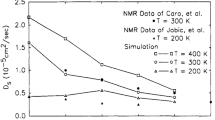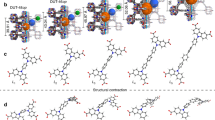Abstract
Highly flexible nanoporous materials, exhibiting for instance gate opening or breathing behavior, are often presented as candidates for separation processes due to their supposed high adsorption selectivity. But this view, based on “classical” considerations of rigid materials and the use of the Ideal Adsorbed Solution Theory (IAST), does not necessarily hold in the presence of framework deformations. Here, we revisit some results from the published literature and show how proper inclusion of framework flexibility in the osmotic thermodynamic ensemble drastically changes the conclusions, in contrast to what intuition and standard IAST would yield. In all cases, the IAST method does not reproduce the gate-opening behavior in the adsorption of mixtures, and may overestimates the selectivity by up to two orders of magnitude.







Similar content being viewed by others
References
Banerjee, Debasis, Liu, Jun, Thallapally, Praveen K.: Separation of C2 hydrocarbons by porous materials: metal organic frameworks as platform. Comments Inorg. Chem. 35(1), 18–38 (2015)
Bourrelly, S., et al.: Different adsorption behaviors of methane and carbon dioxide in the isotypic nanoporous metal terephthalates MIL-53 and MIL- 47. J. Am. Chem. Soc. 127, 13519–13521 (2005)
Brandani, S., Mangano, E., Sarkisov, L.: Net, excess and absolute adsorption and adsorption of helium. Adsorption 22(2), 261–276 (2016)
Coudert, F.-X., et al.: Thermodynamics of guest-induced structural transitions in hybrid organic-inorganic frameworks. J. Am. Chem. Soc. 130(43), 14294–14302 (2008)
Coudert, F.-X., et al.: Prediction of breathing and gate-opening transitions upon binary mixture adsorption in metal-organic frameworks. J. Am. Chem. Soc. 131(32), 11329–11331 (2009)
Coudert, F.-X.: The osmotic framework adsorbed solution theory: predicting mixture coadsorption in flexible nanoporous materials. Phys. Chem. Chem. Phys. 12(36), 10904 (2010)
Coudert, F.-X.: Responsive metal-organic frameworks and framework materials: under pressure, taking the heat, in the spotlight, with friends. Chem. Mater. 27(6), 1905–1916 (2015)
Escobedo, F.A.: Novel pseudoensembles for simulation of multicomponent phase equilibria. J. Chem. Phys. 108(21), 8761 (1998)
Foo, M.L.: An adsorbate discriminatory gate effect in a flexible porous coordination polymer for selective adsorption of CO2 over C2H2. J. Am. Chem. Soc. 138(9), 3022–3030 (2016)
Gücüyener, C., et al.: Ethane/ethene separation turned on its head: selective ethane adsorption on the metal-organic framework ZIF-7 through a gate-opening mechanism. J. Am. Chem. Soc. 132(50), 17704–17706 (2010)
Hoffmann, H.C., et al.: High-pressure in situ 129Xe NMR spectroscopy and computer simulations of breathing transitions in the metal-organic framework Ni2 (2,6-ndc)2 (dabco) (DUT-8(Ni)). J. Am. Chem. Soc. 133(22), 8681–8690 (2011)
Horike, S., Shimomura, S., Kitagawa, S.: Soft porous crystals. Nat. Chem. 1(9), 695–704 (2009)
Inubushi, Y., et al.: Modification of flexible part in Cu\(^{2+}\) interdigitated framework for CH\(_4\)/CO\(_2\) separation. Chem. Comm. 46(48), 9229 (2010)
Joarder, B., et al.: Guest-responsive function of a dynamic metal-organic framework with a \(\pi\) Lewis acidic pore surface. Chem. Eur. J. 20(47), 15303–15308 (2014)
Kitaura, R., et al.: Porous coordination-polymer crystals with gated channels specific for supercritical gases. Angew. Chem. Int. Ed. 42(4), 428–431 (2003)
Lan, A., et al.: RPM3: a multifunctional microporous MOF with recyclable framework and high H\(_2\) binding energy. Inorg. Chem. 48(15), 7165–7173 (2009)
Li, L.: Exploiting the gate opening effect in a flexible MOF for selective adsorption of propyne from C1/C2/C3 hydrocarbons. J. Mater. Chem. A 4(3), 751–755 (2016)
Li, D., Kaneko, K.: Hydrogen bond-regulated microporous nature of copper complex-assembled microcrystals. Chem. Phys. Lett. 335(1–2), 50–56 (2001)
Mehta, M., Kofke, D.A.: Coexistence diagrams of mixtures by molecular simulation. Chem. Eng. Sci. 49(16), 2633–2645 (1994)
Mukherjee, S., et al.: Framework-flexibility driven selective sorption of p-Xylene over other isomers by a dynamic metal-organic framework. Sci. Rep. 4, 5761 (2014)
Mukherjee, S., et al.: Exploiting framework flexibility of a metal-organic framework for selective adsorption of styrene over ethylbenzene. Inorg. Chem. 54(9), 4403–4408 (2015)
Myers, A.L., Monson, P.A.: Physical adsorption of gases: the case for absolute adsorption as the basis for thermodynamic analysis. Adsorption 20(4), 591–622 (2014)
Myers, A.L., Prausnitz, J.M.: Thermodynamics mixed-gas adsorption. AIChE J. 11(1), 121–127 (1965)
Nijem, N., et al.: Tuning the gate opening pressure of metal-organic frameworks (MOFs) for the selective separation of hydrocarbons. J. Am. Chem. Soc. 134(37), 15201–15204 (2012)
Ortiz, A.U., et al.: Predicting mixture coadsorption in soft porous crystals: experimental and theoretical study of CO\(_2\)/CH\(_4\) in MIL-53(Al). Langmuir 28(1), 494–498 (2012)
Sanda, S., Parshamoni, S., Konar, S.: Third-generation breathing metal-organic framework with selective, stepwise, reversible, and hysteretic adsorption properties. Inorg. Chem. 52(22), 12866–12868 (2013)
Serre, C.: Very large breathing effect in the first nanoporous chromium(III)-based solids: MIL-53 or Cr. J. Am. Chem. Soc. 124(45), 13519–13526 (2002)
Simon, C.M., Smit, B., Haranczyk, M.: pyIAST: ideal adsorbed solution theory (IAST) python package. Comput. Phys. Comm. 200, 364–380 (2016)
Suwanayuen, S., Danner, R.P.: A gas adsorption isotherm equation based on vacancy solution theory. AIChE J. 26, 68–76 (1980)
Sweatman, M.B., Quirke, N.: Predicting the adsorption of gas mixtures: adsorbed solution theory versus classical density functional theory. Langmuir 18, 10443–10454 (2002)
Tanaka, D.: Kinetic gate-opening process in a flexible porous coordination polymer. Angew. Chem. Int. Ed. 47(21), 3914–3918 (2008)
van Assche, T.R.C., Baron, G.V., Denayer, J.F.M.: Molecular separations with breathing metal-organic frameworks: modelling packed bed adsorbers. Dalton Trans. 45(10), 4416–4430 (2016)
Yang, R.T.: Gas separation by adsorption processes. Imperial College Press, London (1997)
Zang, J., Nair, S., Sholl, D.S.: Osmotic ensemble methods for predicting adsorption-induced structural transitions in nanoporous materials using molecular simulations. J. Chem. Phys. 134(18), 184103 (2011)
Author information
Authors and Affiliations
Corresponding author
Electronic supplementary material
Below is the link to the electronic supplementary material.
Rights and permissions
About this article
Cite this article
Fraux, G., Boutin, A., Fuchs, A.H. et al. On the use of the IAST method for gas separation studies in porous materials with gate-opening behavior. Adsorption 24, 233–241 (2018). https://doi.org/10.1007/s10450-018-9942-5
Received:
Revised:
Accepted:
Published:
Issue Date:
DOI: https://doi.org/10.1007/s10450-018-9942-5




